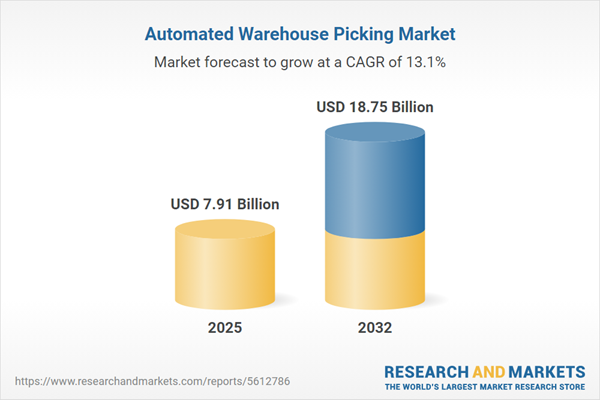Speak directly to the analyst to clarify any post sales queries you may have.
Automated warehouse picking is reshaping supply chain operations by offering flexible, advanced solutions that help senior decision-makers drive agility, responsiveness, and efficiency across logistics environments. As more organizations turn to automated systems, the focus is shifting to optimizing both short-term performance and long-term scalability.
Market Snapshot: Automated Warehouse Picking Market Overview
The automated warehouse picking market has emerged as a central driver in logistics transformation worldwide, currently valued at USD 7.01 billion with a projected 13.08% CAGR through 2032. The sector's acceleration is rooted in the escalating adoption of automation to address labor shortages, rising consumer expectations, and the need for resilient supply chains. Organizations are updating logistics frameworks to improve reliability and maintain uninterrupted operations, while strategic investment in scalable solutions enables businesses to adapt quickly to changing market dynamics.
Scope & Segmentation of Automated Warehouse Picking Solutions
- Technologies Adopted: Automated guided vehicles, pick-to-light systems, voice recognition platforms, modular robotics, and put wall technologies combine to automate complex and repetitive picking processes, enhancing productivity and raising accuracy.
- End User Industries: Automotive, e-commerce, food and beverage, healthcare, manufacturing, pharmaceuticals, retail, and third-party logistics sectors are leveraging automation to achieve greater order precision and meet fast-changing customer needs.
- System Types Supported: Automated storage and retrieval systems, vertical lift units, carousel modules, and shuttle-based platforms are being implemented to optimize warehouse layouts and streamline inventory management, enabling tailored solutions for diverse operational goals.
- Picking Methods Employed: Batch, cluster, wave, and zone picking approaches are used to maximize throughput, allowing real-time adaptation of picking workflows to meet fluctuating order volumes and evolving business strategies.
- Deployment Models: Cloud-based and on-premise options support seamless integration, ensuring compatibility with both legacy IT structures and enterprise security requirements in various organizational contexts.
- Organization Sizes Served: Custom automation solutions cater to the needs of small businesses, mid-sized enterprises, and global corporations, supporting sustainable improvements through all phases of growth.
- Regions Active: The Americas, Europe, Middle East, Africa, and Asia-Pacific represent active regions, each faced with distinct regulatory, workforce, and infrastructure challenges that shape automation adoption and planning strategies.
- Lead Companies: Industry leaders such as Daifuku, KION Group, SSI Schaefer, Murata Machinery, Honeywell International, Swisslog, KNAPP, AutoStore, Zebra Technologies, and GreyOrange set industry benchmarks and continuously advance technology throughout the sector.
Key Takeaways for Senior Decision-Makers
- Implementing real-time data analysis and AI-powered platforms delivers broader supply chain visibility and actionable distribution performance insights.
- Integrating collaborative robotics and advanced sensors enhances workplace safety, supporting better cooperation between automated systems and human workers.
- Employing hybrid automation models increases flexibility and continuity, equipping organizations to manage change during market fluctuations or disruptive events.
- User-centric picking interfaces simplify onboarding and transitions, helping maintain accuracy through system changes or upgrades.
- Modular automation and digital twin technologies make implementation easier and ongoing monitoring more effective for process optimization.
- Energy-efficient, recyclable automation aligns operations with emerging compliance expectations and environmental sustainability goals.
Tariff Impact: Navigating the 2025 Regulatory Landscape
Shifting tariff regulations in 2025 will require organizations to reevaluate supply chain partnerships and distribution strategies within automated warehouse picking operations. Adopting flexible, modular automation and diversifying supplier relationships can help mitigate compliance risk. Strategic alliances and proactive maintenance will further enhance business resilience as companies navigate evolving regulatory frameworks worldwide.
Methodology & Data Sources
This market analysis draws on direct interviews with warehouse operators, automation technology experts, and solution providers. Structured secondary research and benchmarking validate all insights, ensuring that intelligence is actionable and relevant to senior decision-makers considering automated warehouse picking.
Why This Report Matters
- Provides senior leaders with practical strategies for implementing advanced picking technologies to boost logistics efficiency and consistency.
- Enables companies to align automation investments with sector and regional requirements, supporting effective compliance and operational outcomes.
- Guides organizations in managing regulatory shifts and applying risk management best practices within rapidly evolving fulfillment environments.
Conclusion
Automated warehouse picking positions organizations to adapt and strengthen supply chains amid future challenges. Strategic commitment to automation unlocks new levels of resilience and capability across logistics operations.
Additional Product Information:
- Purchase of this report includes 1 year online access with quarterly updates.
- This report can be updated on request. Please contact our Customer Experience team using the Ask a Question widget on our website.
Table of Contents
3. Executive Summary
4. Market Overview
7. Cumulative Impact of Artificial Intelligence 2025
Companies Mentioned
The companies profiled in this Automated Warehouse Picking market report include:- Daifuku Co., Ltd.
- KION Group AG
- SSI Schaefer Group
- Murata Machinery, Ltd.
- Honeywell International Inc.
- Swisslog AG
- KNAPP AG
- AutoStore AS
- Zebra Technologies Corporation
- GreyOrange Pte. Ltd.
Table Information
| Report Attribute | Details |
|---|---|
| No. of Pages | 193 |
| Published | November 2025 |
| Forecast Period | 2025 - 2032 |
| Estimated Market Value ( USD | $ 7.91 Billion |
| Forecasted Market Value ( USD | $ 18.75 Billion |
| Compound Annual Growth Rate | 13.0% |
| Regions Covered | Global |
| No. of Companies Mentioned | 11 |









